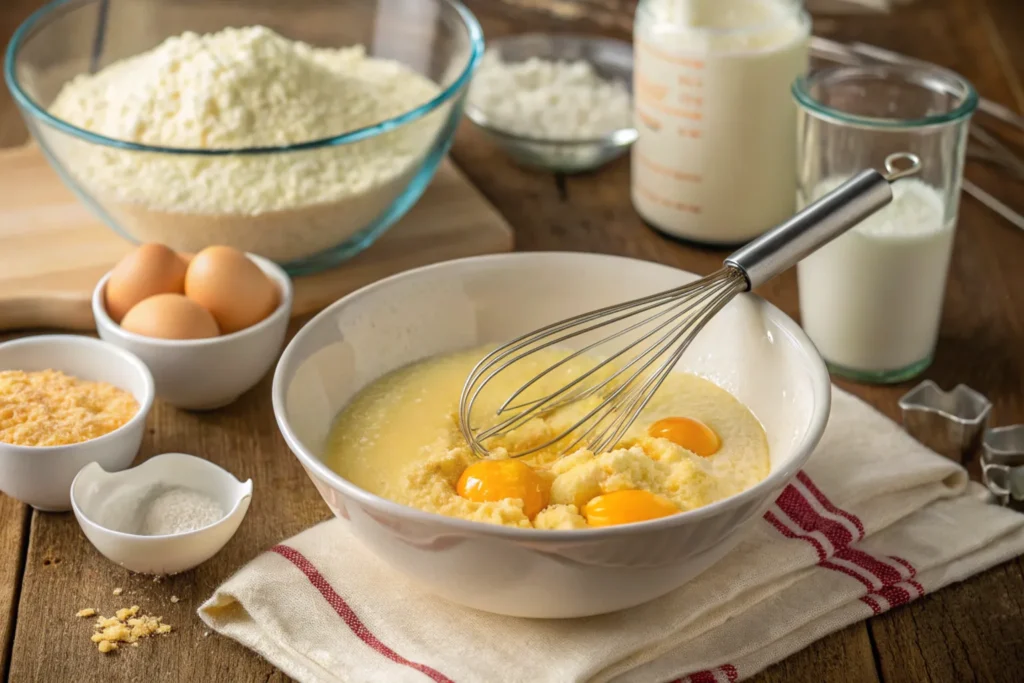Corn bread pudding is a delicious, comforting dish that blends the rich, moist texture of corn pudding with the warm, crumbly goodness of cornbread. Whether you’re craving something savory or sweet, this versatile dish can complement a variety of meals or even shine as the main event. In this guide, we’ll explore everything from its history and essential ingredients to expert tips and mouth-watering recipes that will make corn bread pudding your new favorite comfort food. Let’s dive right in!
What Is Corn Bread Pudding?
Corn bread pudding is a traditional side dish that has won hearts across America, especially in the Southern states. It strikes the perfect balance between a savory casserole and a sweet, moist pudding, making it a beloved holiday staple.
History and Origins
Corn bread pudding traces its roots to early American settlers who adapted Native American corn-based recipes. Since cornmeal was a staple ingredient that could be stored for long periods, it naturally became the foundation for many creative dishes, including this comforting casserole. As time went on, different regions added their own unique twists. For instance, some areas preferred sweeter versions with honey or maple syrup, while others leaned toward savory variations featuring cheese or spices. Consequently, corn bread pudding evolved into a versatile dish that can be enjoyed in countless ways today.
Traditional vs. Modern Versions
Traditional corn bread pudding recipes are straightforward, using only cornmeal, milk, eggs, and butter. Modern interpretations, however, take this simple dish to the next level with additions like cheddar cheese, green chilies, or bacon crumbles. Some recipes even incorporate sweet corn kernels or a touch of honey for added flavor and texture. Whether you prefer the old-fashioned simplicity or a contemporary twist, corn bread pudding remains a versatile dish perfect for any occasion.
Essential Ingredients for Corn Bread Pudding
Creating the perfect corn bread pudding starts with selecting the right ingredients. Whether you’re making a savory version or leaning toward something sweeter, understanding each component is key to achieving that irresistible texture and flavor.
Cornmeal Varieties
Cornmeal is the heart of corn bread pudding. It comes in different grinds, from fine to coarse. Fine-ground cornmeal makes the dish smooth and custardy, while coarse-ground cornmeal adds a delightful crunch. Some recipes even use self-rising cornmeal mix for extra lift.
Sweeteners: Sugar, Honey, or Maple Syrup
Sweeteners balance the natural earthiness of cornmeal. Granulated sugar is common in classic recipes, but you can swap it with honey or maple syrup for a richer, deeper sweetness. For a savory twist, skip the sweeteners altogether or reduce the amount.
Add-Ins: Cheese, Jalapeños, and More
To truly elevate your corn bread pudding, consider adding cheddar cheese for a creamy, savory touch. Moreover, if you enjoy a bit of heat, try incorporating diced jalapeños or green chilies, which work wonders for adding spice. Additionally, for extra depth of flavor, consider tossing in bacon bits, caramelized onions, or even roasted bell peppers. Ultimately, the possibilities are endless, allowing you to customize the dish to suit your personal taste preferences.
How to Make Corn Bread Pudding
Mastering corn bread pudding is easier than you think. With a few simple steps, you’ll be serving up a golden, perfectly baked dish that’s sure to impress.
Step 1: Prepping Ingredients
Before you begin, gather all your ingredients. Preheat the oven to 350°F (175°C) and grease a baking dish with butter or non-stick spray. This prevents sticking and ensures a beautifully browned crust.
Step 2: Mixing and Combining

In a large mixing bowl, combine cornmeal, flour, sugar, and baking powder. In another bowl, whisk together eggs, milk, melted butter, and cream-style corn. Slowly add the wet ingredients to the dry mixture, stirring gently until just combined. Be careful not to overmix, as this can make the pudding dense.
Step 3: Baking Techniques for Perfect Texture
Pour the mixture into the prepared baking dish. For an extra-cheesy finish, sprinkle shredded cheddar on top. Bake for 45-50 minutes or until the top is golden brown and a toothpick inserted into the center comes out clean. Let the pudding rest for at least 10 minutes before serving to set the creamy interior.
Best Recipes for Corn Bread Pudding
When it comes to making corn bread pudding, the recipe possibilities are endless. From classic Southern styles to creative spins, there’s something for every taste. Here are a few must-try recipes that will take your love for this dish to the next level.
Classic Southern Corn Bread Pudding Recipe
For a true taste of Southern comfort, nothing beats the classic version. Combine cornmeal, sweet corn kernels, cream-style corn, eggs, and butter for a traditional, rich dish. The result is moist, slightly sweet, and perfect for family dinners or holiday feasts.
Cheesy Corn Bread Pudding Recipe
Looking for something more savory? Add sharp cheddar, Monterey Jack, or pepper jack cheese for a gooey, cheesy twist. Mix in diced green chilies for a hint of spice, and you’ll have a satisfying casserole that pairs beautifully with roasted meats.
Vegetarian and Vegan Alternatives
For a plant-based twist, substitute almond milk or coconut milk for dairy. Use a flaxseed egg instead of traditional eggs and skip the cheese, or opt for vegan cheddar. These changes create a delicious and guilt-free version of corn bread pudding that everyone can enjoy.
Serving and Pairing Suggestions
Wondering how to serve corn bread pudding to impress your guests? Whether it’s a weeknight dinner or a festive gathering, pairing this dish the right way enhances its flavors and presentation.
What to Serve with Corn Bread Pudding
Corn bread pudding makes an excellent side dish for barbecued ribs, roast chicken, or grilled vegetables. Its sweet and savory balance complements smoky, spicy, or tangy main courses. For a lighter meal, serve it alongside a crisp green salad with citrus vinaigrette.
Occasions for Corn Bread Pudding
This dish isn’t just for Thanksgiving or holiday parties. Its simplicity and versatility make it perfect for potlucks, family dinners, or even weekend brunches. You can also serve it as a warm breakfast dish with a drizzle of maple syrup for a sweet start to your day.
With its rich flavor and irresistible texture, corn bread pudding is sure to be the star of any meal!
Troubleshooting and Expert Tips
Even seasoned cooks can run into issues when making corn bread pudding. But don’t worry—these expert tips will help you avoid common pitfalls and serve up a flawless dish every time.
Preventing Soggy Corn Bread Pudding
One of the biggest challenges is avoiding a soggy texture. To prevent this:
- Use the right baking dish: Opt for a shallow, wide dish to ensure even baking.
- Drain canned corn thoroughly: Excess liquid can make the pudding too wet.
- Don’t overmix the batter: Stir just until combined to keep the texture light and airy.
Achieving the Right Texture and Flavor
Texture is everything when it comes to corn bread pudding. Here’s how to get it just right:
- Bake until golden brown: The top should be firm and lightly browned.
- Let it rest before serving: Cooling for 10-15 minutes allows the pudding to set properly.
- Experiment with flavors: Add green onions, herbs, or bacon for savory depth. If you prefer it sweeter, a sprinkle of cinnamon or nutmeg can add warmth.
FAQs:
1. What’s the Difference Between Cornbread Pudding and Cornbread Casserole?
While cornbread pudding and cornbread casserole share similar ingredients, they differ in texture and purpose. Cornbread pudding is a softer, more custard-like dish made with a mixture of cornmeal, eggs, milk, and sometimes cream-style corn. Its moist, tender consistency is similar to a dessert pudding, though it can be savory or sweet.
On the other hand, cornbread casserole is firmer and more structured, often baked with ingredients like cheddar cheese, green chilies, and bacon. Its texture resembles a thick, hearty cornbread but with a rich, casserole-like filling. Both dishes are delicious but cater to different taste preferences and serving styles.
2. What Do You Eat With Corn Pudding?
Corn pudding is a versatile side dish that pairs well with a variety of main courses. Its slightly sweet and savory flavor complements roast turkey, grilled chicken, barbecue ribs, or pulled pork. For a vegetarian-friendly meal, serve it alongside roasted vegetables, green beans, or a fresh salad.
For holiday meals, corn pudding is often served with stuffing, cranberry sauce, and mashed potatoes, making it a staple at Thanksgiving and Christmas gatherings. Its balanced taste works well with both rich and lighter dishes.
3. How Do Southerners Eat Cornbread?
In the South, cornbread is a beloved staple often served alongside greens, beans, or chili. It’s common to crumble cornbread into a bowl of buttermilk for a traditional Southern snack. Many Southerners also enjoy it warm, topped with butter, honey, or even molasses.
During family meals, cornbread often accompanies dishes like fried chicken, catfish, or barbecue pulled pork. Whether served sweet or savory, cornbread is a cherished comfort food across Southern homes.
4. Why Is It Called Bread Pudding?
The term bread pudding comes from its historical roots. In medieval times, cooks used stale bread soaked in milk or cream, mixed with eggs, sugar, and spices to create a pudding-like dessert. This process turned otherwise discarded bread into a delicious, custard-like treat.
Similarly, cornbread pudding follows the same principle—combining cornbread with moist ingredients like milk, eggs, and butter to create a soft, rich, and flavorful dish that’s satisfying and comforting.
Conclusion
Cornbread pudding is a versatile and comforting dish that deserves a place on your dining table. Its perfect balance of sweetness, heartiness, and rich texture makes it suitable for both everyday meals and special celebrations. Whether served as a side dish or the main star of the meal, its warm, satisfying flavors appeal to people of all ages.
What makes cornbread pudding truly special is its adaptability. For instance, you can keep it classic with a traditional Southern recipe featuring cornmeal, eggs, milk, and butter. Alternatively, enhance it with flavorful additions like cheddar cheese, green chilies, or bacon bits for a savory twist. On the other hand, if you prefer something sweeter, consider adding maple syrup, honey, or even a sprinkle of cinnamon to elevate its dessert-like appeal. In either case, cornbread pudding remains a delicious and customizable dish that fits any occasion.
This dish is easy to make and even easier to customize. It pairs wonderfully with barbecue meats, roasted vegetables, or even a simple green salad. It’s perfect for holiday feasts, potlucks, or family dinners, making it a go-to recipe that never disappoints.
So, the next time you’re craving something cozy and satisfying, whip up a warm, golden cornbread pudding. It’s a timeless classic that’s guaranteed to delight your family and friends with every delicious bite!
Relevant Links Added:
- Substitute for Sour Cream in Corn Casserole:
Enhance your corn bread pudding by learning about sour cream substitutes for a creamier texture. Read more here. - What’s the Difference Between Corn Pudding and Scalloped Corn?
Understand how corn bread pudding compares to similar dishes like scalloped corn and choose the right recipe for your meal. Learn more here.

